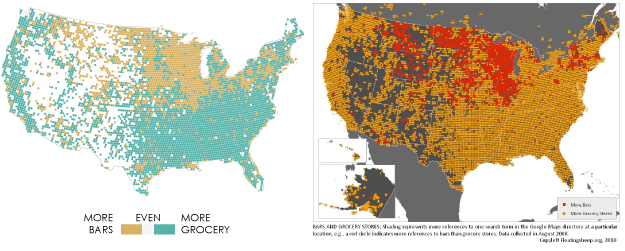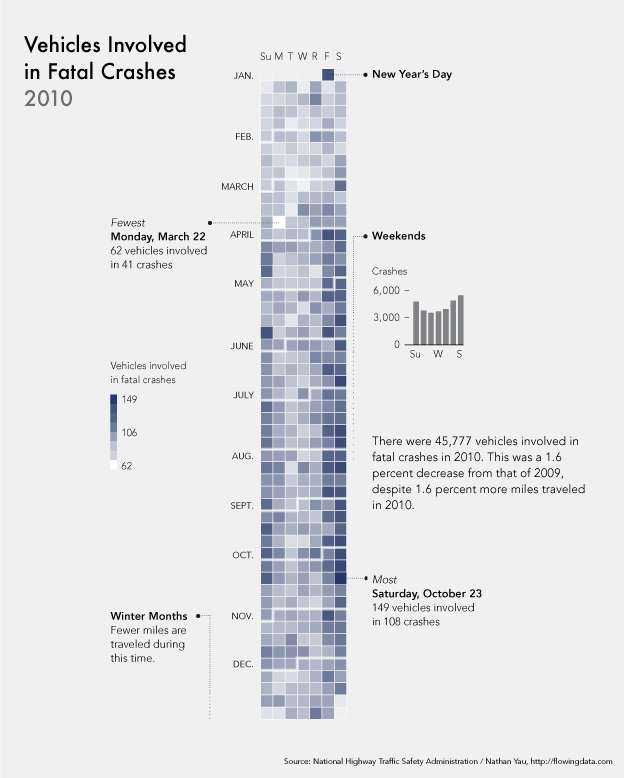Visualization Link: http://www.economist.com/blogs/graphicdetail/2017/03/daily-chart-23
I came across this article while researching for my Individual Project. I was intrigued by the visualization and decided to read and understand it better. However, when I attempted the visualization without reading the article, I found it hard to get any valuable insights. On reading the article a couple of times and looking back at the visualization then, I understood what the author wished to convey.
To explain this visualization in brief, the legend indicates that homicides are measured per 100,000 population and this measure is called Homicide Rate. The regions are color coded with each region given a color. Latin America and Caribbean region and all countries and cities that fall under this region are in red color, similarly, the African region is given yellow color and North America is given blue. The visualization gives the Homicide Rates for the most dangerous cities and the corresponding ten most dangerous countries to which they belong. On the left we see the ten most dangerous countries listed with their time progressive Homicide Rates indicated in the 10 small graphs one below the other. On the right side of each small graphs for individual country, we see the cities in those countries placed along the X- axis as per their Homicide Rate which is denoted on the Y-axis. For example, Victoria in Mexico has a Homicide Rate of 60. The black solid vertical line one the X-axis indicates the National Homicide Rate for the country. For example, national Homicide Rate for Mexico is close to 16-18. The size of the circles indicates the range of homicides in the city. For example, Acapulco has between 100 and 1000 homicides. All these numbers are of the year 2016 or latest. I guess this fairly explains the contents of the visualization.
There was something intriguing about the visualization that drew my attention to it. For starters, I like the fact that they have tried to be as thorough as possible in explaining the reasons these cities are considered most dangerous. The article helps quite a bit in understanding the visualization and the reason for splitting the cities as per region – Latin America & Caribbean, North America and Africa. The details of cocaine cultivation and transport gives us a context for the reasons for homicides. Another aspect that I liked is that, they have given us multiple levels of homicide information regarding the cities – the National Homicide Rate, City Homicide Rate in comparison to the national Homicide Rate and the raw homicide count for each city. The reason I feel this is helpful is because, it gives us information in more than one dimension like –How many people died due to Homicides in 2016 and how many 100,00 people did homicide kill in that year. The color coding corresponds with the Homicide Rate with red indicating top contributors and blue indicating least which is in alignment with common color perceptions like red being associated to danger, yellow signifying moderation etc. Using size of circles to indicate the number of homicides in the city is also a good choice of visualization tool as we can easily get an idea of which cities have more homicides than the other.
The reason I chose this visualization for the blog is that, it gives us a lot of information that is useful. But it does not do it in the most effective way. I believe that if not for certain flaws, it would have been a very useful visualization in understanding homicides. The most obvious flaw is too much information in one visualization. For instance, the City Homicide Rate, National Homicide Rate and City Homicide count range is all present in one single line. This could lead to confusion and result in the reader forming wrong conclusions due to misinterpretation. For example, if we see Cape Town, we are immediately drawn towards its big circle, seeing that we might form a biased opinion that Cape Town is more dangerous than say a city like San Salvador. But in fact, the Homicide Rate for San Salvador is higher than that of Cape Town. Thus, number of people out of the population dying in San Salvador is much higher than Cape Town. Thus, presenting information about these two variables (the homicide rate and actual homicide count) together is not a good idea. Apart from this there are few other flaws. For example, the graphs of the countries on the left indicating the national Homicide Rate look incomplete and crammed up to fit the available space. Apart from the first and last graph of El Salvador and Jamaica, none of the other graphs in between have the upper limit demarcation on the Y-axis, the audience is expected to infer that the remaining graphs also have the same upper limit of Y-axis of 100. The graphs themselves being too small are difficult to read, to figure out the Homicide Rate at a particular point in time.
The article mentions that 43 of the 50 most dangerous cities in the world belong in the three regions mentioned in the graph. But if you count the number of names of cities on the graph, you will find that all 43 names are not present. Also, there are some circles in the graph which do not have names, especially if you see cities in Brazil. There are only four city names mentioned but we can see many more circles than four. The reader could have questions seeing this as to whether the additional circles represent homicides in cities not mentioned in the graph or do they mean something else. This is big inconsistency that may lead the audience to feel confused as to what does the visualization wants to convey. Also, the claim that these countries and cities are the most dangerous is not well supported with data. There is no mention of what is the global median Homicide Rate and how high are the Homicide Rates of these countries mentioned in comparison to this median rate.
I believe the entire visualization could have been broken down in at least 3 individual visualization and told as a story with interactive filters.
- The first visualization could have consisted information just about the Homicide Rates of the 10 most dangerous countries (currently conveyed through the tiny graphs on the left side of the visualization). It could have included details of the time varying homicides in the countries and the reasons attributing to it, thus giving a sense of why the homicide rates are quite high in these countries.
- The second visualization should have been for the city Homicide Rates in comparison with the national rate. In this visualization, we could simply plot the Homicide Rates of the city and the national Homicide Rate for the country alone without introducing the circles of different shape which cause confusion and potentially mislead the reader. Thus, it would give us the idea as to how each city fares in comparison to its national rate and in comparison, to each other.
- The third visualization could be a Map Chart with all the cities and their countries and the size of circles indicating the number of homicides in each city. Using the size of circles to indicate number of homicides and the map chart itself to plot these cities and countries would help visualize the authors claim that Latin American and Caribbean regions remain the World’s most dangerous regions. I believe this breakdown would make it easy to understand the individual pieces of information and the story of how these pieces together indicate the most dangerous parts of the world when it comes to homicides.

Above is a similar visualization found in a 2014 Huffington Post article gives similar insights on 10 countries with highest murder rates. As we can see using the Map clearly conveys the regional dominance of Americas in Homicides that is mentioned in our visualization as well.
- Along with the breakdown of visualizations, another improvement would be if there was more information of the global median Homicide Rates, which would have given a clear idea as to how much higher are the rates in these dangerous countries than the global median Homicide Rate.
References: http://www.huffingtonpost.com/2014/04/10/worlds-highest-murder-rates_n_5125188.html













